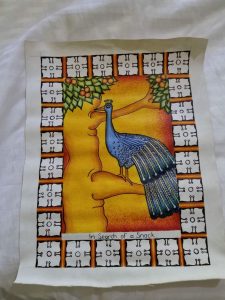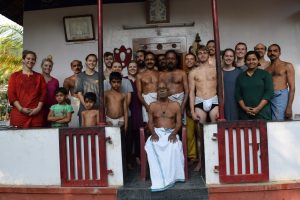A day in the life at the Sarang Center, second person POV:
6:15 am: First alarm
6:20: Second alarm
6:22: Get out of bed, throw Kalari clothes on
6:31: Take Rickshaw to Kalari
6:47: Arrive, lather oil on body, go through bowing routine
7:01: Smile and grimace after Guru-ji starts class with “Three laps!, one more, one more!”
8:30: leave class a bit more flexible and with the knowledge that you will be feeling this in muscles you didn’t know you had
8:45: Arrive back at the houses, gather breakfast, eat with your 9 housemates by sitting in a circle – on couches, on chairs, on the floor – & talk about each other’s mornings
9:12: Take shower if your gracious housemates are able to fill the water tank
10:00: Violin class! (I’m a complete newbie… God bless our ears)
12:00: nap time.
1:30: lunch. Gather food, sit in circle, discuss the current snack situation.
2:00-7:30: free time! Options include, but are not limited to:
- read
- class assignments

- practice violin
- provide for your family by braving the heat and head to town for snacksonsnackonsnacks
- play with children
- Journal
- Read
- Go for a run in a nearby village & gain new running buddies, usually in the form of curious, lanky adolescents with wide smiles and “hello, where from?”
- Read
- Pass out invitations to neighbors for upcoming program that your group will be putting on
7:30: supper! Eat again with your house, discuss pressing topics such as:
- Is everybody okay with a no-pants rule?
- The restaurant situation in Harrisonburg – McDonald’s or Cuban Burger? Quality or quantity?
- Youth group reminiscences, good and bad
- Who is going to eat the last popper?
- How is percussion going, Trevor?
- “Why EMU needs a frisbee golf course” – a persuasive speech by Trevor Oyer
- Spirit Animals
- State of the Snackage (not to be confused with State Of The Union)
10ish: Set alarm, climb in to bed, and whisper an assuring “yes, we can” to your hamstrings in preparation for the next day of classes
 On a more serious note: Our time at the Sarang Center was, for me, a much needed change of pace after our time in Goa. We lived in houses, interacted with neighbors, and experienced the unpredictability of life in India through tentative schedules and iffy water/electricity availability. It was the first time our living space was truly “off the grid” with no internet/TV within close proximity. It wasn’t rare for me to walk downstairs and see 5-7 people sitting in a circle, reading between classes, or walk outside and see other group members playing badminton or soccer with neighborhood friends. Some houses even went the extra mile, inviting neighbor kids over to paint, play games, and exchange words from respective languages.
On a more serious note: Our time at the Sarang Center was, for me, a much needed change of pace after our time in Goa. We lived in houses, interacted with neighbors, and experienced the unpredictability of life in India through tentative schedules and iffy water/electricity availability. It was the first time our living space was truly “off the grid” with no internet/TV within close proximity. It wasn’t rare for me to walk downstairs and see 5-7 people sitting in a circle, reading between classes, or walk outside and see other group members playing badminton or soccer with neighborhood friends. Some houses even went the extra mile, inviting neighbor kids over to paint, play games, and exchange words from respective languages.
 We each got to pick two classes to take for two weeks. Options included Kalari (an Ancient Kerala martial arts form), Carnatic Vocal, percussion, or violin, mural painting, cooking, yoga, and theater. When our time came to an end, we all participated in a program to share what we learned with demonstrations from each class. It was humbling to see familiar faces in the crowd, ranging from faces we would pass on our way to class, local shop owners, and our own gurus.
We each got to pick two classes to take for two weeks. Options included Kalari (an Ancient Kerala martial arts form), Carnatic Vocal, percussion, or violin, mural painting, cooking, yoga, and theater. When our time came to an end, we all participated in a program to share what we learned with demonstrations from each class. It was humbling to see familiar faces in the crowd, ranging from faces we would pass on our way to class, local shop owners, and our own gurus.
I am deeply grateful for the community we were surrounded with for those two weeks, as they developed a home-stay feel for our large group through their hospitality and openness within their own space despite our somewhat invasive and curious presence.
This amount of traveling and level of exposure to so many aspects of India does provide a more well-rounded view of the country, but it can be overwhelming. Time at the Sarang Center gave me an Indian-esque type of stability and “home” in the midst of all the movement on this journey.
-Abigail Shelley

